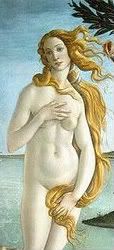
Unlike his contemporary, Raphael, who was known for his more accurate way of painting the human body, Botticelli's work takes considerable artistic license. If you look closely, you'll immediately notice that the length of the Venus' neck has been dramatically exaggerated. Moreover, her left arm (your right) looks like it's practically falling off! This is perhaps one of the major reasons that Botticelli's work was nearly forgotten after his death.
It's hard to imagine that there was ever a time when this painting was practically unknown. But it was nearly forgotten in the wake of Botticelli's death and Raphael's popularity (along with Leonardo and Michelangelo). As time went on, art critics ignored Botticelli's work, which was regarded as inferior and unrealistic. He was "rediscovered" in the 19th century by--surprise, surprise--the Pre-Raphaelites.
Botticelli's anatomically imaginative work made him the enemy of the art establishment, who thought he was merely careless. But these same perceived shortcomings endeared Botticelli to the Pre-Raphaelites in general, and Sir Edward Coley Burne Jones in particular (Levey, 299), who was impressed by the way Botticelli masterfully blended the pagan and Christian traditions within his artwork. Burne-Jones spoke often about his love for Botticelli, and his enthusiasm seems to have been contagious. William Michael Rossetti purchased one of Botticelli's drawings in 1867 (which later turned out to be a fake, but, oh well. At least he had been turned on to the artist). By the beginning of the 20th century, Botticelli's popularity had risen to such meteoric levels that "between 1900 and 1920, more books were published on Botticelli were printed than any other great painter"(291). This was due in a large part due to the enthusiasm of the Pre-Raphaelites.
Tomorrow: Ruskin and Botticelli
Source Consulted: Michael Levey. "Botticelli and Nineteenth-Century England." Journal of the Warburg and Courtauld Institutes, Vol. 23, No. 3/4 (Jul. - Dec., 1960), pp. 291-306.
(This is a GREAT article that I recommend to anyone who can get their hands on it! It's available through JSTOR, for those of you who have subscriptions).
Wednesday, September 3, 2008
Botticelli and the Pre-Raphaelites
Posted by
Margaret
at
6:51 AM
![]()
![]()
Labels: edward burne-jones, pre-raphaelites
Subscribe to:
Post Comments (Atom)


10 comments:
Her face is so like the Pre-Raphaelites' work. One can certainly see the influence.
Oh boy, tomorrow, Ruskin! My hero. Well, one of them anyway.
I have always wondered about that rubbery left arm! :)
As for Botticelli's reputation and the disregard of his art, don't discount Botticelli's association with Savonarola. Although the Bonfire of the Vanities myth is just that, a myth, his association with that group had profound effects. His Medici patronage dried up when they were driven from the city, and upon their return they held a grudge. Nevertheless, you can see aspects of Botticelli the in Mannerists, especially in Parmigianino and El Greco.
One other thing, take a look at this work by Albrecht Durer, Eve. Durer is famous for his accurate renditions yet here, Eve's shoulder appears dislocated. The tree on the left appears to be used to add the dramatic effect of windblown hair.
Please excuse the double post and transposed "in the" in the previous link.
Out of curiosity, do you use The Web Gallery of Art? I never noticed the image on the landing page until today.
Who would thought that the PRB would have 'rediscovered' Botticelli. This is fascinating Margaret. I look forward to reading about the Ruskin connection.
Thanks, Stephen! As you will find tomorrow, the Rusking is a little disappointing, but kind of funny!
Thank you for the link, boba. I had actually never run into the web gallery of art before. What a useful website!
The Pre-Raphaelite associate, John Roddam Spencer Stanhope (1822-1907), had a villa in Bellosguardo in Florence that overlooked Botticelli's house in the countryside. What an inspirational view for a Pre-Raphaelite to have!!
In 2004 the Uffizi did a lovely exhibition on the Pre-Raphaelites and Florence. It is "I Giardini delle Regine" and has an English version. The repros are great.
The Uffizi's exhibitions sounds wonderful! I would have love to have seen it. Interesting information about Stanhope--I didn't know that!
John Roddam Spencer Stanhope corrected once / J. R. S. Stanhope corregido una vez
http://www.youtube.com/watch?v=-Ca7lAkzhAE
John Roddam Spencer Stanhope corrected twice / J. R. S. Stanhope corregido dos veces
http://www.youtube.com/watch?v=LelL_yOrTeM
Post a Comment